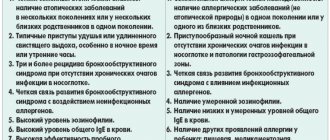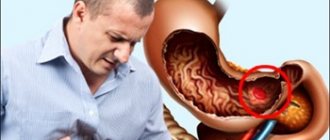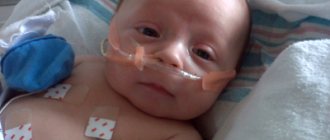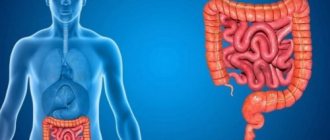Answered by Alexandra Andreevna Metelina, pediatrician and gastroenterologist at CTA.
Very young children (up to one year old) suffer from appendicitis extremely rarely; other diseases accompanied by abdominal pain and general malaise are more common in this group. For example, intussusception, acute pyelonephritis, or an intestinal infection (viral or bacterial) may present with similar symptoms.
It is believed that children 3-4 years old are not prone to appendicitis. But I have more than once seen appendicitis in a four-year-old child while on duty in a hospital, and inflammation of the appendix develops rapidly, sometimes with lightning speed. Therefore, let's talk about the symptoms in detail so that you notice them in time and call a doctor immediately.
Causes of appendicitis
The exact reasons for the development of the inflammatory process are still unclear. But there are several common options:
- Disturbance in the balance of microflora - bacteria that are safe in a normal environment become toxic and cause inflammation.
- Vasospasm causes deterioration in tissue nutrition. Some areas die and become a source of infection.
- Stagnation in the intestines - feces, foreign bodies, neoplasms or parasites can close the lumen of the appendix. At the site of closure, mucus accumulates, where the microbiome begins to multiply. Narrowing and compression of the appendix disrupts blood circulation and lymph flow, which leads to rapid progression of inflammation and necrosis of appendix tissue.
A predisposing factor will be frequent constipation, which forms fecal stones.
Gut is thin
Intestinal intussusception also occurs in young children, which also gives a picture of an acute abdomen. What happens? The intestine of the lower section is “implemented” into the overlying one. Due to the resulting narrowing, the intestinal vessels are pinched and blood circulation is disrupted.
The main danger is that necrosis (death of tissue) of the intestine may develop. In infants, intussusception most often occurs due to improper introduction of complementary foods with vegetables or fruits, which increase peristalsis. Moreover, this happens much more often in boys than in girls. In older children, the cause may be an abnormal protrusion of the wall of the small intestine, polyps on the inner wall of the intestine, a tumor and other pathologies that impair motility. Very often the disease develops suddenly:
● The child cries, breaks out in sweat, bends over, twists his legs.
● After the first attack, which lasts 5–10 minutes, the child becomes lethargic and apathetic until the next attack. As the attacks become more frequent, bloating develops.
● Blood is visible in the stool.
● Vomiting may occur, after which peristalsis can be heard; vomit contains blood mixed with mucus, resembling raspberry jelly.
● Sometimes between attacks you can feel a lump in the intestines - a “bump” in the tummy.
● Your temperature may rise.
If such symptoms appear, the child must be hospitalized immediately. If no more than 12–18 hours pass from the first attack of pain to the start of treatment, the strangulated area of the intestine can be saved.
To establish a diagnosis of intussusception, the child is given an x-ray: an enema with a barium sulfate solution is given so that the damaged area becomes “visible” during examination.
If time is not lost, air is pumped into the colon through the rectum, and under the influence of pressure it gradually straightens.
When the child is brought to the hospital too late, surgery is necessary. It can be performed using laparoscopy: the surgeon manually, applying slight pressure, straightens the damaged area. In cases where necrosis of the intestinal tissue does occur, the surgeon cuts out the damaged area and then stitches the healthy edges of the intestine.
Symptoms of appendicitis
The appendix is located in the lower abdomen. The first symptom is unbearable pain that appears in the navel area and spreads to the lower right side of the abdomen. The pain worsens over a short period of time when moving, taking a deep breath, coughing or sneezing.
Other typical symptoms:
- nausea, even vomiting
- decreased or complete lack of appetite
- constipation or, conversely, diarrhea
- flatulence, painful bloating
- fever, chills, symptoms of intoxication
- urge to defecate
Signs of inflammation of the appendix may differ in men and women. For example, women experience nausea, vomiting and fever. At the beginning of the development of the disease, the pain is pressing, pulling, and not even necessarily on the right side, which can be mistakenly recognized as gynecological problems.
Then the pain may become cramping, such symptoms most often occur in the evening or at night.
In men with acute inflammation, severe pain in the abdominal area and spontaneous tightening of the right testicle occur. When the scrotum is pulled back, discomfort and pain occur in the anal area and a strong urge to have a bowel movement.
In older people, the symptoms of appendicitis may appear less clearly: minor pain, mild nausea. At the same time, appendicitis in older people is often characterized by a severe course and the development of complications.
In children under 5 years of age, the symptoms of appendicitis are not as pronounced as in adults. The pain often has no clear localization. Appendicitis in a small child can be recognized by increased body temperature, diarrhea and the presence of plaque on the tongue.
What do the tests say?
If appendicitis is suspected, a complete clinical blood test (CBC) and a general clinical urinalysis (UCA) are taken; it is advisable to do this within the first hours after the onset of the disease. In a general blood test for appendicitis, there should be high leukocytes and a large number of band neutrophils, and the ESR may also increase. But if a child has appendicitis, a urine test is usually normal. And if the urine is not sterile, with bacteria, white blood cells and red blood cells - together, both of these tests indicate a urinary tract infection or renal colic, and you will certainly be referred for an ultrasound and to a pediatrician for antibacterial therapy.
If you have taken tests in the laboratory without calling a doctor, and you see that all urine indicators are normal, and leukocytes, neutrophils and ESR are above normal, do not offer the child any more water or drink, pack a bag with things (passport , policy, birth certificate, SNILS, slippers, pajamas, hygiene products), call an ambulance or go to the hospital yourself.
Attention! Do not give your child any painkillers until examined by a doctor; do not place a heating pad or ice on his stomach so that the picture of appendicitis is not blurred. Your actions can complicate the diagnosis and waste time.
Types of pathology
Acute appendicitis develops rapidly and manifests itself with pronounced symptoms. With inaction, the pain intensifies and inflammation can lead to serious complications.
By its nature, acute appendicitis can be complicated or uncomplicated. Uncomplicated pathology, in turn, has 2 forms: catarrhal (only the mucous membrane is inflamed), destructive (deeper layers are affected).
Chronic is a fairly rare form. In most cases, it develops as a result of acute appendicitis in the absence of treatment. Has the same symptoms, but they manifest themselves very sluggishly. There are periods of exacerbation and remission, like any chronic disease.
Chronic appendicitis is also divided into subtypes:
- Residual - a consequence of acute appendicitis that ended in self-healing. It manifests itself as a dull aching pain in the right iliac region.
- Recurrent – has a paroxysmal nature: exacerbations occur from time to time, followed by remission.
- Primary chronic – develops independently, without preceding acute appendicitis.
Diagnosis of appendicitis
The first step in examining a patient is an examination and history taking. The doctor asks you to tell us when the symptoms began and how long the discomfort lasts. This is important to understand in order to distinguish the disease from something else.
It is important to consider other factors that could cause the development of appendicitis:
- Surgical operations in the abdominal area in the recent past.
- Taking medications or supplements.
- Bad habits, abuse of alcohol, drugs, etc.
Feeling the abdomen will help determine the location and intensity of pain, its characteristics. A pelvic and rectal examination may be necessary. The final diagnosis is made only after laboratory tests. Blood and urine tests can help detect signs of inflammation or other health problems.
Visual examination methods may also be required - ultrasound of the abdominal organs, CT or MRI. They will allow:
- determine the condition of the appendix and assess its integrity
- detect signs of inflammation
- evaluate blockage inside the appendix
- identify an abscess or other complications
What to do to prevent appendicitis, and can it be cured without surgery?
Currently, the only method of treating appendicitis - from the point of view of evidence-based medicine - is surgical treatment, but research is also being conducted on conservative therapy (“Is conservative therapy for acute appendicitis possible?” Prof. S.A. Sovtsov, Prof. A.G. Krieger, Candidate of Medical Sciences O.V. Pribytkova, A.V. Smirnov, Federal State Budgetary Educational Institution of Higher Education "South Ural State Medical University" of the Ministry of Health of Russia, Federal State Budgetary Institution "Institute of Surgery named after A.V. Vishnevsky" of the Ministry of Health of Russia, 2021 .; Early appendectomy vs. conservative management in complicated acute appendicitis in children: A meta-analysis. Fugazzola P, Coccolini F, Tomasoni M, Stella M, Ansaloni L., General and Emergency Surgery dept, Bufalini Hospital, Cesena, Italy. Pediatrics dept. and Neonatal and Pediatric Intensive Care Unit, Bufalini Hospital, Cesena, Italy. 2019, etc.). Yes, of course, people who lead a healthy lifestyle and adhere to a rational, age-appropriate diet have a lower chance of encountering appendicitis. But there is no absolutely effective prevention. Let's proceed from the fact that we all benefit from preventing constipation and regular physical activity - all this allows us to stimulate intestinal function and avoid the formation of fecal stones and spontaneous spasms in the gastrointestinal tract.
The appendix is a branch of the cecum ranging from 4 to 20 centimeters in length and only 1 centimeter in diameter. This worm-like appendage is located where the small intestine meets the large intestine. Bacteria easily colonize in this place and fecal stones can get stuck, so the appendix, consisting of lymphoid tissue, performs immune and protective functions in relation to the intestines. (The tonsils and adenoids protect the respiratory organs in the same way.) Inflammation of the appendix often occurs when its mouth is blocked, usually due to the accumulation of fecal stones. The appendix can also become inflamed after a spasm of the intestines due to the consumption of large amounts of protein foods, fast carbohydrates and foods rich in fats, against the background of an intestinal infection that provokes excessive growth of bacteria in the intestine. In all cases, vasospasm, blood stagnation and swelling of the smooth muscles of the intestines occur. Because of this, the nutrition of the appendix is disrupted, bacteria from the intestinal lumen penetrate the walls of the appendix, and an active inflammatory process begins, which is almost always accompanied by pain.
About Lisa, Yasha and Dima - real stories from mothers
Lisa (8 months old) had a sharp rise in temperature, she cried without interruption for more than an hour, her tummy seemed larger than usual, she had loose stools, and a few hours after the temperature spike, she began to lie down, pulling her legs towards her stomach. I gave her Nurofen, but there was no change in Lisa’s condition, and we went to the hospital. (Later we realized that it was not worth giving Nurofen and wasting time). At the hospital, doctors first suggested an intestinal infection or disease of the abdominal cavity, and also said that this could be a change in the anatomy of the intestine. They did a blood test and found high white blood cells, a high ESR (about 90 units), and a urine test showed no signs of inflammation. Lisa then had an ultrasound, which at first showed nothing but severe flatulence, which made it difficult to see anything else. Then the ultrasound diagnostician began to scrutinize the area of the intestine where the appendix was, and finally saw that it was very inflamed. Diagnosis: acute phlegmonous appendicitis with local peritonitis. A few minutes after the ultrasound, Lisa was already on the surgical table. The laparoscopic surgery went well, Lisa recovered quickly. The doctors told us that we did absolutely the right thing by arriving at the hospital almost immediately, and we, in turn, are very grateful to the doctors for the high-quality diagnosis and successful operation. (Lena, Lisa's mother).
Yasha (6 years old) fell ill with the coxsackie virus at sea, in Turkey. He developed a high temperature, characteristic spots appeared on his legs and arms, and his appetite decreased - everything is as usual with a viral infection. After a couple of days, the temperature dropped, but he did not eat better, even refused ice cream, and drank only water. He was lethargic and thoughtful, but never complained of abdominal pain. We called a doctor, the doctor examined Yasha, and then for the first time, while palpating his abdomen, Yasha screamed that he was in pain. The doctor said that this is most likely a consequence of inflammation caused by the coxsackie virus, it’s okay, continue therapy, and if the temperature persists, come and take a blood test. We asked the question: is this appendicitis? - and received the answer that no, this is pain caused by a virus, due to which, apparently, the liver or intestines were slightly inflamed. It was on Friday, and on Saturday morning Yasha was already holding his stomach, pressing his leg to his stomach and could not get to the toilet on his own. We took him to the hospital in our arms, where he was immediately given a blood test, which showed very high leukocytes and ESR, and an ultrasound revealed that the appendix (yes, it was appendicitis) had already burst. After 20 minutes, Yasha was already on the operating table; the abdominal surgery lasted an hour and a half. Unfortunately, we were unlucky with a general practitioner, and we ourselves did not have sufficient information about how to recognize appendicitis. Please don't repeat our mistakes. (Zhenya, Yasha’s mother).
Dima (10 years old) began to complain of headache and nausea, he vomited several times and was put to bed. I decided that it was a rotavirus, because such cases had happened before. By evening, the temperature rose to 37.8, Dima did not want to eat anything, he drank water and lay down. In the morning the temperature was 37.2, there was no appetite, I insisted that I at least eat oatmeal with water. During the day, Dima complained for the first time of abdominal pain, not severe, according to him. I was at work all day, we called each other, his condition did not change, his stomach did not hurt more. In the morning everything was the same, the temperature remained at 37.2-37.5 and I called a pediatrician from the Central Clinical Hospital and went to work (there was a nanny at home). About two hours later the doctor called me and said that she was calling an ambulance to Dima because there was a serious suspicion of appendicitis. The ambulance arrived with me, Dima was taken to the clinic in Polyanka, they did a blood test, an ultrasound, and immediately took him to surgery. The surgeon said that in just a couple of hours the appendix would have burst, and then laparoscopic surgery would not have been possible. I concluded that when complaining of abdominal pain, even minor ones, the first step is to rule out appendicitis and not trust any of your previous experiences. And, of course, it’s good when there are wonderful, attentive doctors nearby!..)) (Irina, Dima’s mother)
How to treat appendicitis?
The pathology requires immediate treatment, since the appendage may burst and its contents will spill into the abdominal cavity and peritonitis will begin. Therefore, the only solution is to remove the appendix surgically.
Appendectomy is a surgical operation to remove the appendix. It can be carried out in two ways:
- classic – abdominal surgery
- laparoscopic, when there are no large incisions
Abdominal surgery is performed if the appendix ruptures and if its contents spill into the abdominal cavity, as well as if the rupture causes an abscess.
Laparoscopy is considered the most modern method of removing the appendix for various reasons: less invasiveness, quick recovery, and fewer complications.
The operation is carried out as follows:
- the surgeon makes small incisions through which access to the appendix appears
- a camera with illumination is introduced
- other instruments are used to remove the process
- areas are treated to disinfect infectious material
- the operated area is examined and sutures are placed
What will happen in the hospital.
In the emergency room, the child will have an ultrasound and will be examined by a surgeon. If the appendix is inflamed, and tests confirm this, if you have not fed or watered the child for at least 3.5 hours, he will be immediately taken to the operating room. There, using laparoscopy (these are 3 small punctures), the inflamed appendix will be removed through a small hole and a healthy baby will be returned to you, completely free of appendicitis. After 4 hours he will be able to get up and drink water, but all this is only if you have time before the complications begin. If for some reason laparoscopic surgery is not possible, abdominal surgery will be performed and the recovery period will take longer.









